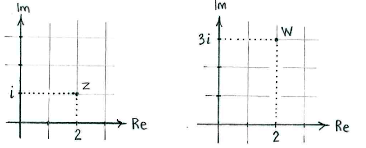Solution 3.2:1a
From Förberedande kurs i matematik 2
(Difference between revisions)
m |
|||
| Line 1: | Line 1: | ||
| - | + | In the complex number plane, the number <math>z=2+i</math> corresponds to a point in the plane with coordinate 2 along the real axis (''x''-axis) and coordinate 1 along the imaginary axis (''y''-axis). In a corresponding way, <math>w=2+3i</math> has the coordinate 2 along the real axis and 3 along the imaginary axis. | |
| - | In the complex number plane, the number <math>z=2+i</math> corresponds to a point in the plane with coordinate | + | |
| - | + | ||
| - | + | ||
[[Image:3_2_1_a.gif|center]] | [[Image:3_2_1_a.gif|center]] | ||
Current revision
In the complex number plane, the number \displaystyle z=2+i corresponds to a point in the plane with coordinate 2 along the real axis (x-axis) and coordinate 1 along the imaginary axis (y-axis). In a corresponding way, \displaystyle w=2+3i has the coordinate 2 along the real axis and 3 along the imaginary axis.

